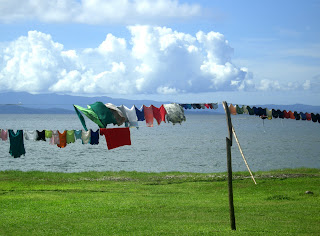




 It is quiet around here now that the boys have gone back to their island, but today is the first day of school, so the children are out and about in their uniforms, with their backpacks and big smiles. We hitched a ride into Somosomo for our dinner with Jone and Losena. Their three children, and several nephews were present, busy shoveling dirt off the pit where fish, chicken and taro were cooking. This is called a lovo feast. The food is placed on mats and set on hot rocks, then covered with huge taro leaves, and dirt is placed on top for weight. Losena made fresh passion fruit juice and we feasted, sitting on mats on the ground. The kids all wanted their pictures taken; we will send them to the family, laminated, so they will survive the heat and humidity.
After dinner, a couple from Australia, friends of the family, joined in our visit. They are missionaries, Jehovah's Witness,and have been helping the family grieve over the loss of their son (see previous post). The children made us flower leis, and we shared food, chatted and laughed, telling stories of our different cultures. At the end of the evening, Losena gifted me a with a tapa, or masi, which is a Fifian bark cloth made from the paper Mulberry tree. It is stripped of bark and the white inside is used for making the cloth. They pound and pound, add water, pound, and meld pieces together, sort of like the art of felting. The coloring is derived from natural ingredients such a powdered roots & plants. Tapa is used for clothing on ceremonial occasions, chiefs, weddings, exchanging gifts, and wall decorations. I am privileged to have received this gift; we are told that the art of tapa is dying out, and only a few people on the island know how to create it. It is completely lost to the Hawaiians, who used to create the same handicraft (creating different designs for different clans).
Lucy, Losena's daughter, gifted us with a flower, the Tagimaucia, which grows around a lake high up in the hills; this flower grows no where else in the world but here; attempts to grow it elsewhere have failed! The legend goes that a girl was forbidden to marry a beloved chief's son, and in her sorrow, sat down, dug her heels into the earth and while pushing with her feet, cried and cried, shedding tears that formed the lake around which this flower grows.
We gifted the family with my Alaskan books, colored pencils for the kids, and small sewing kits. At the end of the evening, the Australians gave us a ride home, and all the kids piled in for the ride. Another starry night.
It is quiet around here now that the boys have gone back to their island, but today is the first day of school, so the children are out and about in their uniforms, with their backpacks and big smiles. We hitched a ride into Somosomo for our dinner with Jone and Losena. Their three children, and several nephews were present, busy shoveling dirt off the pit where fish, chicken and taro were cooking. This is called a lovo feast. The food is placed on mats and set on hot rocks, then covered with huge taro leaves, and dirt is placed on top for weight. Losena made fresh passion fruit juice and we feasted, sitting on mats on the ground. The kids all wanted their pictures taken; we will send them to the family, laminated, so they will survive the heat and humidity.
After dinner, a couple from Australia, friends of the family, joined in our visit. They are missionaries, Jehovah's Witness,and have been helping the family grieve over the loss of their son (see previous post). The children made us flower leis, and we shared food, chatted and laughed, telling stories of our different cultures. At the end of the evening, Losena gifted me a with a tapa, or masi, which is a Fifian bark cloth made from the paper Mulberry tree. It is stripped of bark and the white inside is used for making the cloth. They pound and pound, add water, pound, and meld pieces together, sort of like the art of felting. The coloring is derived from natural ingredients such a powdered roots & plants. Tapa is used for clothing on ceremonial occasions, chiefs, weddings, exchanging gifts, and wall decorations. I am privileged to have received this gift; we are told that the art of tapa is dying out, and only a few people on the island know how to create it. It is completely lost to the Hawaiians, who used to create the same handicraft (creating different designs for different clans).
Lucy, Losena's daughter, gifted us with a flower, the Tagimaucia, which grows around a lake high up in the hills; this flower grows no where else in the world but here; attempts to grow it elsewhere have failed! The legend goes that a girl was forbidden to marry a beloved chief's son, and in her sorrow, sat down, dug her heels into the earth and while pushing with her feet, cried and cried, shedding tears that formed the lake around which this flower grows.
We gifted the family with my Alaskan books, colored pencils for the kids, and small sewing kits. At the end of the evening, the Australians gave us a ride home, and all the kids piled in for the ride. Another starry night.










































